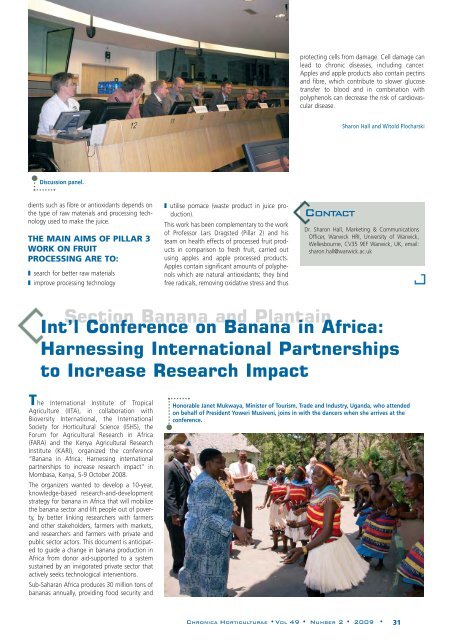Chronica Horticulturae volume 49 number 2 ... - Acta Horticulturae
Chronica Horticulturae volume 49 number 2 ... - Acta Horticulturae
Chronica Horticulturae volume 49 number 2 ... - Acta Horticulturae
You also want an ePaper? Increase the reach of your titles
YUMPU automatically turns print PDFs into web optimized ePapers that Google loves.
protecting cells from damage. Cell damage can<br />
lead to chronic diseases, including cancer.<br />
Apples and apple products also contain pectins<br />
and fibre, which contribute to slower glucose<br />
transfer to blood and in combination with<br />
polyphenols can decrease the risk of cardiovascular<br />
disease.<br />
Sharon Hall and Witold Plocharski<br />
Discussion panel.<br />
dients such as fibre or antioxidants depends on<br />
the type of raw materials and processing technology<br />
used to make the juice.<br />
THE MAIN AIMS OF PILLAR 3<br />
WORK ON FRUIT<br />
PROCESSING ARE TO:<br />
❚ search for better raw materials<br />
❚ improve processing technology<br />
❚ utilise pomace (waste product in juice production).<br />
This work has been complementary to the work<br />
of Professor Lars Dragsted (Pillar 2) and his<br />
team on health effects of processed fruit products<br />
in comparison to fresh fruit, carried out<br />
using apples and apple processed products.<br />
Apples contain significant amounts of polyphenols<br />
which are natural antioxidants; they bind<br />
free radicals, removing oxidative stress and thus<br />
CONTACT<br />
Dr. Sharon Hall, Marketing & Communications<br />
Officer, Warwick HRI, University of Warwick,<br />
Wellesbourne, CV35 9EF Warwick, UK, email:<br />
sharon.hall@warwick.ac.uk<br />
Section Banana and Plantain<br />
Int’l Conference on Banana in Africa:<br />
Harnessing International Partnerships<br />
to Increase Research Impact<br />
The International Institute of Tropical<br />
Agriculture (IITA), in collaboration with<br />
Bioversity International, the International<br />
Society for Horticultural Science (ISHS), the<br />
Forum for Agricultural Research in Africa<br />
(FARA) and the Kenya Agricultural Research<br />
Institute (KARI), organized the conference<br />
“Banana in Africa: Harnessing international<br />
partnerships to increase research impact” in<br />
Mombasa, Kenya, 5-9 October 2008.<br />
The organizers wanted to develop a 10-year,<br />
knowledge-based research-and-development<br />
strategy for banana in Africa that will mobilize<br />
the banana sector and lift people out of poverty,<br />
by better linking researchers with farmers<br />
and other stakeholders, farmers with markets,<br />
and researchers and farmers with private and<br />
public sector actors. This document is anticipated<br />
to guide a change in banana production in<br />
Africa from donor aid-supported to a system<br />
sustained by an invigorated private sector that<br />
actively seeks technological interventions.<br />
Sub-Saharan Africa produces 30 million tons of<br />
bananas annually, providing food security and<br />
Honorable Janet Mukwaya, Minister of Tourism, Trade and Industry, Uganda, who attended<br />
on behalf of President Yoweri Musiveni, joins in with the dancers when she arrives at the<br />
conference.<br />
CHRONICA HORTICULTURAE •VOL <strong>49</strong> • NUMBER 2 • 2009 • 31
















